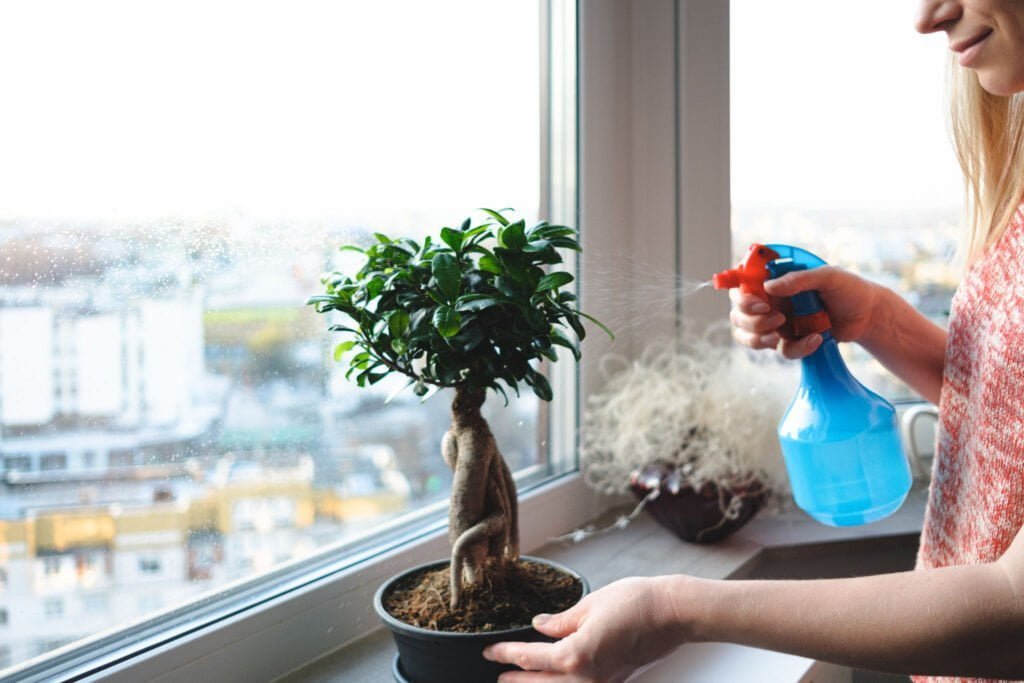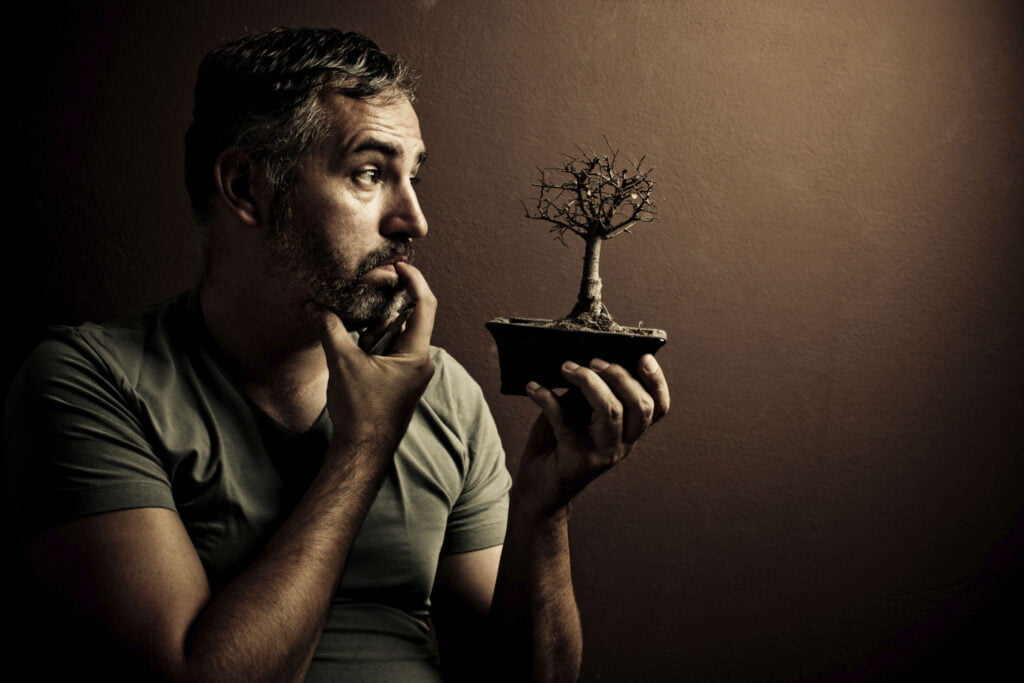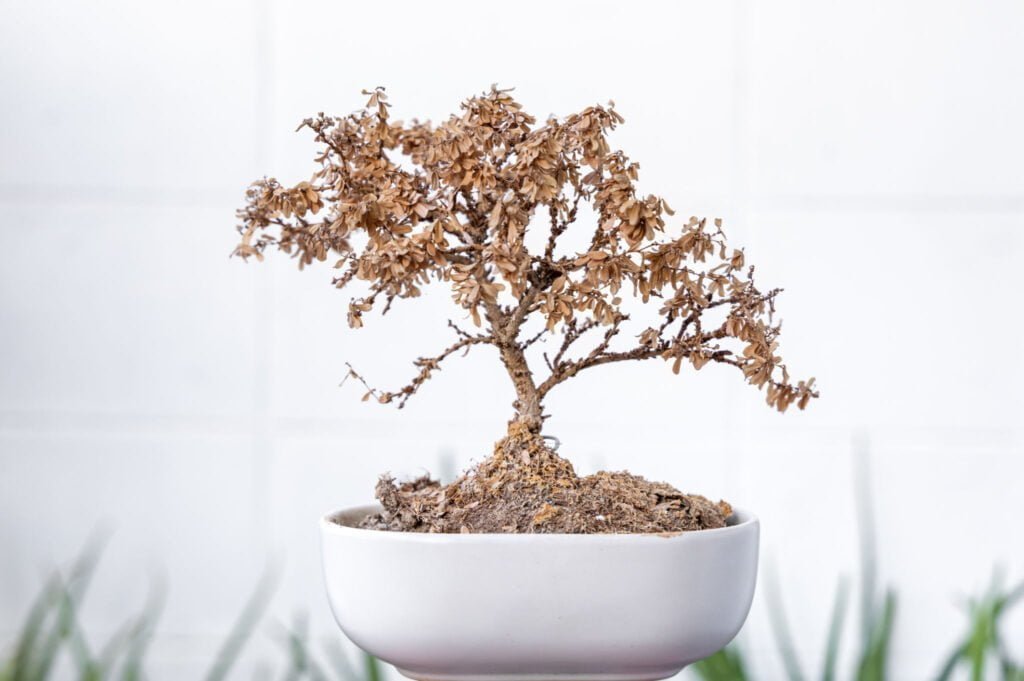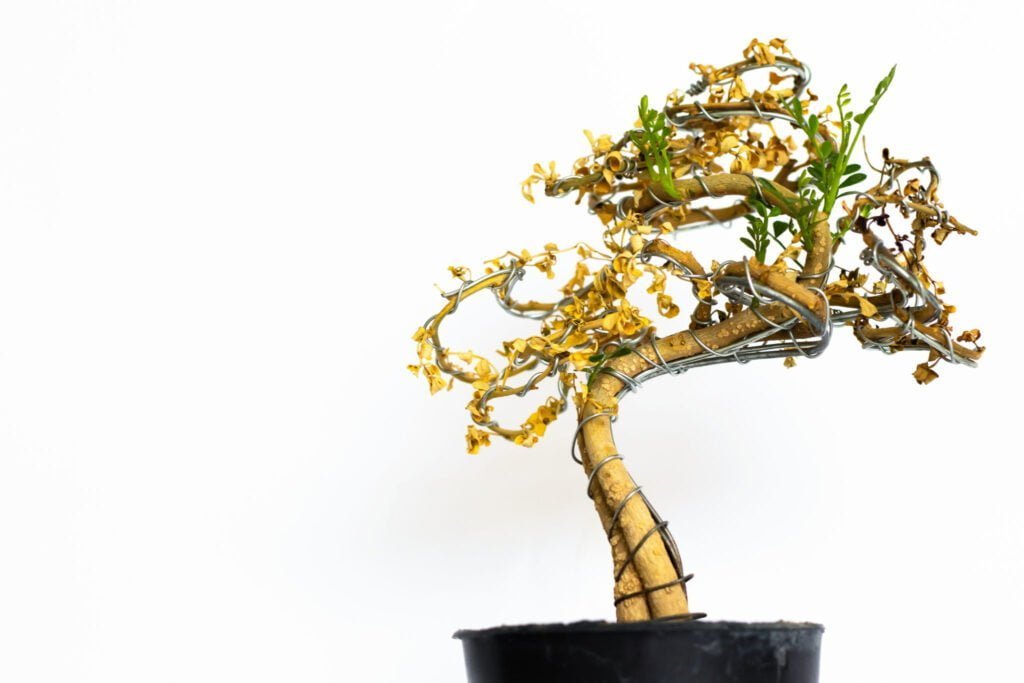What can I do if my bonsai is dropping leaves? This is the most common question asked by bonsai enthusiasts!
Leaf dropping or shedding is an experience that almost every bonsai enthusiast has encountered. Many times, the cause of bonsai dropping leaves is due to mistakes in bonsai care.
However, with a little background knowledge, Bonsai dropping leaves can be avoided or reduced to a minimum. In this article, you will learn some helpful information about the reasons and solutions for bonsai dropping leaves.
Top Reasons for Bonsai Dropping Leaves
You can easily identify the cause of leaves dropping after figuring out whether your Bonsai Tree belongs indoors or outdoors. Below mentioned are some of the most common reasons for dropping leaves.
Let’s get into more detail about each,
Bonsai tools are essential for maintaining the health and beauty of your bonsai trees. From pruning shears to concave cutters, each tool has a specific purpose in bonsai care. You can find a variety of bonsai tools online to help you with your pruning, wiring, and repotting needs. High-quality bonsai tools can make all the difference in creating and maintaining beautiful bonsai trees.
Reason 1: Lack of Sufficient Light
The main reason for your indoor Bonsai leaves dropping is insufficient sunlight. It’s no surprise these plants love the sun. For most bonsai species, indoor light is not enough for growth.
While insufficient light will not kill a plant immediately, it will delay its growth. This can lead to the dropping of leaves. But if you prune the tree, the leaves and branches will eventually stop growing.
For maximum growth, place the bonsai tree on a windowsill that receives the most sunlight. But, many outdoor species of Bonsai cannot withstand extreme temperatures. Hence, their internodes and nodes can grow too large. As a result, these species can also shed their leaves. Always keep these things in mind.

Reason 2: Improper drainage
As miniature trees, Bonsai are grown in smaller pots. Unlike other potted plants, indoor and outdoor bonsai require special care.
The drainage becomes an issue as there is a limited amount of space and nutrients for trees grown in smaller pots.
During watering, if the water does not drain quickly or at all, you may notice it is “rootbound”. It’s a condition in which the root system is disrupted. As a result, roots will have difficulty absorbing water and nutrients.
It is more likely that these trees will dry up quickly or that overwatering will cause them to retain extra moisture. This is why these plants often display symptoms like yellowing leaves and shedding leaves out of season.
Reason 3: Underwatering
There are different water requirements for bonsai based on their species, weather, and location. Also, the water requirements of plants change throughout the year. In comparison to other plants, these dwarf trees need extra care while watering.
In pots, bonsai have limited space for water and nutrients. In indoor species, a lack of humidity and heating or cooling systems lead to drying out quickly.
Within days, the leaves drop due to dry soil. Some outdoor species can survive underwatering to a level, as nearby plants provide humidity.
For watering bonsai, the best option is rainwater and the second best is bottled water.
Reason 4: Overwatering
As soon as beginners begin growing bonsai, they become passionate about it. As a result of their extra care, the plants are sometimes overwatered.
When your Bonsai tree is overwatered, it develops a condition called “root rot”, which causes the roots to become weak. Additionally, excess moisture retention is another major cause of Bonsai leaf loss.
Using poor quality soil in pots leads to overwatering and water retention. But remember, watering your Bonsai tree during intense sunlight hours or under direct sunlight can burn it.
However, root rot doesn’t happen overnight. Additionally, watering your miniature tree a few times daily will not affect its health.

Reason 5: Underfeeding or overfeeding
For a healthy Bonsai tree, food is essential. There are liquid and solid fertilizers available depending on the species.
When there are not enough nutrients in the soil, the leaves will become lighter in color, and the shoots will not grow properly. Eventually, the disease will be too strong for your tree to overcome.
Normally, plants undergo osmosis where fluids move from the roots to the tree’s leaves. However, if you overfeed your tree, plasmolysis occurs, and fluids move in an opposite direction instead of osmosis. During plasmolysis, the leaves lose their color and begin to fall out.
During the growth season, bonsai require feeding roughly once a month. Fertilizers are primarily composed of nitrogen (N), phosphorus (P), and potassium (K). Your bonsai will do best with an organic feed combined with beneficial microorganisms. If you are refining, ensure that you use a low nitrogen feed.
Reason 6: Pests and Disease
Even after following all the care sheets, your Bonsai may shed leaves due to a disease or pest.
Among the most common diseases are root rot, rust, and black spot, as well as fungal diseases like damping, galls, and powdery mildew.
There are also pests that drop leaves from Bonsai trees. Aphid, vine weevil, root aphid, red spider mite, scale insects, and adelgids are the most common pests that damage these plants.

Reason 7: Recent repotting
Did you recently repot your Bonsai? If yes, most, if not all, of the leaves are likely to fall off. There is a good chance that when repotting a bonsai, a bonsai will begin losing its leaves due to root pruning.
In general, repotting Bonsai can be very stressful for them, especially if the plants are sensitive, such as Ficus. Make sure that you only repot the Bonsai in early spring, when they are coming out of dormancy and are coming into full bloom.
In order to maintain a bonsai, the temperature should be around 50F (10C), and bonsai should be kept at 64F (18C) for a few weeks after they have been re-potted.
For 2-3 weeks after repotting, keep your Bonsai in mostly shaded areas. Moreover, keep your bonsai moist, but don’t overwater if it doesn’t have too many leaves.
Wait at least 3-4 weeks before applying fertilizer. Then, choose a fertilizer that contains a higher level of nitrogen or organic fertilizer to boost foliage growth. Adding organic fertilizer to the soil boosts growth by encouraging the growth of beneficial bacteria.

Reason 8: Indoor bonsai relocation
As with all plants, bonsai require a lot of light to thrive. Their energy comes from photosynthesis. Meanwhile, their metabolism consumes energy. Also, when temperatures are high, the metabolism is especially high.
In indoor bonsai, changing the location changes the amount of light. They enter a normal, clearly darker apartment from bright greenhouses. Often, autumn and winter are warmer in the flat than in the greenhouse.
Thus, in indoor bonsai, insufficient light results in low energy production, resulting in high energy consumption.
What is the solution to this problem in bonsai?
It’s quite simple: Drop the leaves inside the crown. Because the energy they consume is greater than the energy they produce.
What can you do to help the Indoor bonsai? For this, Keep your indoor bonsai bright and cool, especially during the dark season. Bright means “as bright as possible”, i.e., directly into the window.
Reason 9: Complete leaf shedding in autumn
This is normal for the bonsai or other deciduous trees in temperate climates. It is almost universal for outdoor bonsai to lose their leaves in autumn. However, coniferous bonsai can also naturally lose their leaves or needles in autumn.
Reason 10: Partial leaf shedding in autumn
In many needle bonsais (including pine-pinus), this is quite normal. It is common for past years’ needles to fall. Also, it depends on the tree species whether this “partial dropping” is normal.
It is common for conifers to shed their needles after a couple of years (for example, the Weymouth pine – Pinus strobus, the Scots pine – Pinus sylvestris, and the spruce – Picea), but some will not shed their needles for years. As an example, Black pine bonsai (Pinus nigra) lose its needles after 3-8 years.
Reason 11: Stress
Environmental strain can also force your bonsai to drop leaves. Bonsai are used to have a certain habit. Frequently changing that habit can easily stress out the plant because of variables such as chilly or strong air infiltrating, disclosure to natural sunlight, or a shaded area that is not appropriate for the species of tree you are developing, etc.
For indoor bonsai trees, keep in the sense that the natural access to indoor sunlight might not be enough to support your bonsai’s well-being. Consider going for an indoor grow light.
As mentioned earlier, you have to have the perfect balance for your bonsai tree that imitates its natural zone and stops stressing it by moving it around. Let your bonsai species use the time to heal and don’t fuss with further treatments if you think that environmental stress is the reason for leaves dropping off.
Reason 12: Low Humidity
Many bonsai trees are tropical species, and when they are cultivated in the dehydrated indoor circumstances found in northern winter environments, they may respond by falling leaves. This is a natural reaction as the tree is trying to preserve its water loss by lessening the number of leaves that are using the moisture. This can be viewed as a state of shock, but because dry winter states are gradually developing, it may happen quite slowly. Keeping the pot on a pot of pebbles and keeping it constantly wet may help with humidity levels. You can even mist the leaves from time to time to control the situation.
Reason 13: Physical Damage
Bonsai trees that are in high-traffic spots in your home or are often touched somehow will occasionally lose leaves inexplicably. Pets and kids scratching the tree can cause leaf drop as well. Try keeping the bonsai in a location where it can’t be touched frequently, or has low traffic, or put it at a height where it will be secure from outside contact.
5 Easy ways to fix dropping leaves in Bonsai

I hope you are now well aware of the reasons behind the shedding of leaves on your masterpiece of art – your bonsai. Now, take a look at these tips for bringing your miniature tree back to life.
1. Properly water your bonsai
When it comes to watering Bonsai plants, there is no hard and fast rule. The only thing you need to do is avoid watering during daylight hours.
If you notice that the top layer of soil is drying out, use a spray bottle to water it. Make sure you let the soil dry between waterings and only water again once the soil is dry.
Also, you can water the foliage by soaking it. It will help the plant absorb moisture from its foliage as well as wash pests away.
Akadama, commonly used for Bonsai, turns reddish when dry, but darker brown when wet. This change in soil color can help you in deciding when to water your Bonsai.
2. Improve Soil Quality
If the water is draining quickly through the bonsai pot, it means that the soil is not absorbing water. This may be because of rootbound or poor-quality soil. At this time, your bonsai will need repotting and pruning of damaged roots.
Also, various soil mixes can be made for bonsai depending on the species. However, Akadama, lava rock, pumice, some river sand, and charcoal work best.
3. Balanced Sunlight Exposure
Lack of sunlight can largely impact bonsai health. Hence, indoor species should be placed on a windowsill for good sunlight exposure. However, if you live in a colder area and have many bonsai species, consider using fluorescent light that emits growth-friendly spectra.
For light-sensitive outdoor bonsai, put them on the balcony with a few hours of shade. Also, it will depend on the light requirements of the species you choose.
Thus, if leaves dropping issues is due to lack of light, you can fix that by changing the location of your bonsai.
4. Balanced Fertilization
Feed your bonsai in a balanced way to promote osmosis, a process by which fluid and nutrients travel from the roots to the tree. In most cases, balanced fertilizers are most suitable for bonsai.
Overfertilization increases soil salt content, which leads to plasmolysis and eventually leaves dropping.
In most cases, you can use both liquid and solid fertilizer. During the growing period of a young plant, liquid fertilizer should be diluted twice a month. In general, solid fertilizers should be applied two times a year.
You can use organic fertilizer as well as synthetic fertilizer. The nutrients in synthetic fertilizers are absorbed by bonsai immediately, without the need for microorganisms. You can also control the amount of food you feed.
Nevertheless, synthetic fertilizer will be largely washed away with the next watering. Whenever possible, avoid synthetic fertilizers because they can kill soil bacteria and mycorrhizal fungi.
Organic fertilizers release nutrients slowly. With an organic fertilizer, you can’t overfeed as easily as you can with synthetic fertilizer. However, it’s harder to control how much of it is released.
However, it is always important to follow the package instructions. Additionally, in the growing season, you should fertilize as often as 1-2 times a month. Also, it is important to use an organic feed that contains a balanced ratio of elements and beneficial microorganisms. Moreover, do not feed in the winter.
5. Disease and Pest Control
Similar to other potted plants, bonsai may drop leaves due to disease and pests. Here is a list of diseases/pests, their symptoms, and treatment plans.
Common diseases in Bonsai, symptoms, and solutions
| Disease | Symptoms | Treatment |
| Leaf Spot Disease | Small brown spots on leaves by molds. Discoloration of leaves. | Use fungicide |
| Powdery Mildew | A powdery white mold appears on the backside of leaves. | Apply an anti-mildew agent. Place your bonsai trees in a sunny spot with good airflow. |
| Sooty Mold | Soot appears on leaves, branches, and the surface of the bonsai trunk. It is caused by mold that is found in the poop of pests. | Use insecticides to kill the pest’s. |
| Root Rot | Fungal attacks due to poor drainage. Messy and entangled roots. | The disease is serious and sometimes impossible to cure. Proper drainage and root care will prevent this condition. |
| Rust and Blackspot | Yellow leaves. Premature leaves dropping in the mid-summer. | Apply fungicide. Remove all the affected leaves. |
Common pests in Bonsai, symptoms, and solutions
| Pests | Symptoms | Treatment |
| Aphids | Aphids feed on the fluids of plants and causes low growth. | Use a brush and applythe pesticide. |
| Red Spider Mite | The white cow webs in the joints between the branches. | Insecticides like Malathionhelp in getting rid of Spider mites. |
| Scale insect | Scale insects suck the fluids out of trees and are seen on the bark and stalk of trees. | Apply a pesticide and remove the scale insects by using a brush. |
Tip: In the case of fungal infections, fungicide must be used. A copper-based fungicide will help cure an infection. When dealing with pests and insects, use insecticides.
Bonsai Dropping Leaves In Summer

Do you worry about your Bonsai dropping leaves in summer? Don’t be alarmed. In the summer, Bonsai leaves drop for a variety of reasons:
- You are not properly watering your Bonsai.
- Repotting may be required for your Bonsai plant.
- It is possible that you overfed your Bonsai.
- There is not enough sunlight reaching your indoor plants.
- Sunlight is too intense for the Outdoor Bonsai tree
- A disease or pest can also cause leaves to shed.
Our above-mentioned tips will help you revive your Bonsai tree and fix all these problems.
Bonsai Dropping Leaves in Winter
Did your Bonsai drop leaves during the winter? If so, don’t panic and keep reading.
In the dormant season, trees lose their leaves in order to retain as much water as possible. As a result, Bonsai leaves drop in winter.
All tree species undergo a period of dormancy during the winter. In response to decreasing day length, deciduous trees drop their leaves and go into dormancy.
The tree’s response to changing day lengths is part of its natural life cycle. By bringing a dormant tree indoors for winter protection, you mess with nature and it will ultimately die.
Whenever the temperature is below zero degrees for more than 48 hours, it is called overwintering.
To increase the temperature by just a few degrees, move your trees to a greenhouse. Also, you can use a horticulture frost cloth to protect your plants from frost.
Moreover, it is best to avoid placing your dormant trees in a heated room. Additionally, bonsai in freezing temperatures require little water during dormancy.
Bonsai Leaves Turning Yellow And Falling Off

Are you wondering why your Bonsai leaves turn yellow and fall off? Here’s why.
During winter, many deciduous and even evergreen species change their leaf color, and they fall off. Similarly, new leaves replace old leaves naturally.
However, if the leaf shedding problem occurs during a season other than autumn or winter, and the shoots turn yellow as well, it could be caused by the following factors. Hence, fix the problem first by following the specific instructions for care.
- Overwatering or underwatering causes water stress.
- The lack of sunlight
- Overwintering
- Diseases or pests
- Over-fertilizing
Bonsai Leaves Turning Brown and Falling Off
Is there any reason why Bonsai leaves turn brown and fall off? Here’s why it happens.
In most cases, overexposure to the sun causes Bonsai leaves to turn brown and fall off. The condition is called “leaf scorch”. Below are some factors that cause leaf scorch:
- Overwatering and underwatering damage roots
- Overexposure to strong winds
- Over-fertilizing
It is possible to bring your Bonsai back to life if you identify the underlying problem soon.
Will the Leaves on My Bonsai Tree Grow Back?
Different things can influence the healing of your bonsai plant, such as the extent of injury, environmental conditions, how many of its parts are alive, and tree species. Among these matters, the first thing you should inspect is the condition of the bonsai. Check whether your bonsai is still alive or already deceased by scanning its cambium layer. It can take a few weeks until you notice improvement in your bonsai tree. Some species even stay unhealthy until the next growing season to display symptoms of healing.
Conclusion
I hope this article helped you learn a great deal about how to deal with the leaves shedding problem in your miniature artistic plant. In bonsai, the most important thing is to choose species that thrive in your climate.
Keep your plants healthy by taking care of them. It is never a good idea to leave them unattended. In the event that you will be away from home for a long period of time, make arrangements so that your plants will be watered in your absence.
There is no doubt that seeing your hobby flourish and bloom with glory gives you a sense of deep satisfaction.
This article may be beneficial to other bonsai lovers, so please feel free to share it with them.
Related Articles
- Propagating Chinese Elm Bonsai Cuttings And From Seeds
- Best Chinese Elm Bonsai Soil and Fertilizer.
- Troubleshooting Common Problems With Chinese Elm Bonsai
- Buy Chinese Elm Bonsai: How Not to Get Scammed When Purchasing a Chinese Elm Bonsai Tree!
- Chinese Elm Bonsai Pruning And Styling.
- Creating a Chinese Elm Bonsai Forest- Step-By-Step Guide.


Oh my goodness! Incredible article dude! Thanks, However I
am encountering problems with your RSS. I don’t know why
I can’t join it. Is there anybody else getting the
same RSS problems? Anyone who knows the answer will you kindly respond?
Thanx!!
Thank you. Yes, we have stopped the feed to avoid poor content. We accept only high quality content written by the experts.